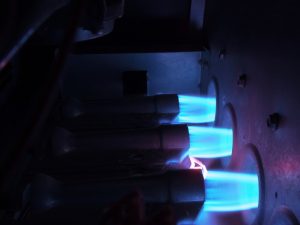 First off, it’s important to note that when we’re talking about heat exchangers in this particular post, we’re talking about those within gas-powered furnaces and heating systems. These gas-powered appliances are not inherently dangerous, but they can become so if not properly cared for.
First off, it’s important to note that when we’re talking about heat exchangers in this particular post, we’re talking about those within gas-powered furnaces and heating systems. These gas-powered appliances are not inherently dangerous, but they can become so if not properly cared for.
Like most powerful appliances, or any appliance that generates combustion gases, a furnace could potentially create health and safety hazards if it’s not maintained on an annual basis, or if it isn’t repairs as soon as symptoms of a problem appear. Treat your gas-powered system well and you’ll have few things to worry about. Ignore a cracked heat exchanger, and that won’t be the case.
What Is a Heat Exchanger?
This is perhaps the most important component of your natural gas heater—the location where the heat from the combustion gas transfers to the air form the blower fan that moves into the ventilation system. This combustion gas shouldn’t come into direct contact with the air, or else unhealthy fumes will end up going into your living space.
Rather, the combustion gas enters the heat exchanger—which is a small metal clam-shaped chamber. The heat of the combustion gas raises the temperature of the metal, and as the air from the blower passes through it, heat transfers to the air. Essentially, the heat exchanger is exactly where the furnace actually heats the air.
The Problem with a Cracked Heat Exchanger
Cracked heat exchangers are the most dangerous problem a furnace can have. It’s most likely to occur in older furnace systems—more than 15 years old. We recommend looking into a replacement sooner than later if your system is this old, because even if you don’t have a cracked heat exchanger right now, it’s a risk if you’re still operating an aging system.
A cracked heat exchanger will allow the exhaust fumes inside the exchanger to leak into your air, with the most toxic of these fumes being carbon monoxide, which can cause severe health problems and it really extreme cases even fatality.
The most common cause for a cracked heat exchanger is corrosion. The reaction between the combustion gas and metal over the years can create a weakening of the metal, which is why it’s something to watch out for in an old furnace. Even the smallest crack is a problem, since it will stretch wider as the heat exchanger turns hot and expands.
How can you tell if you have a cracked heat exchanger? This is something that’s checked during maintenance, but if you haven’t had your appointment yet, then you do need another warning sign. That warning sign is a clicking noise coming from the furnace after the blower shuts off. Also, if your CO detectors go off, you should not ignore it. Instead, you should shut off your furnace, open all the windows in your home, and call immediately for an inspection.
Contact Sound Heating and Air Conditioning Inc. today for quality furnace repair in Puyallup, WA! We take your comfort (and safety) as serious as you do.
